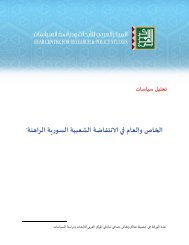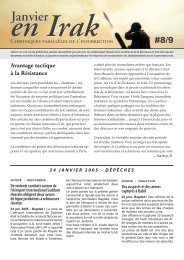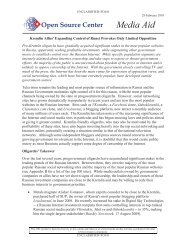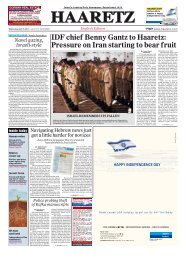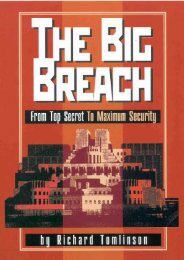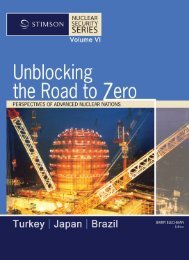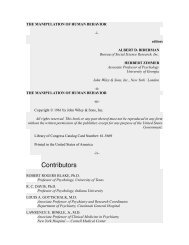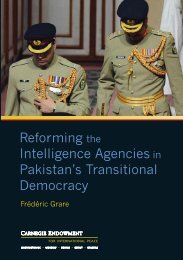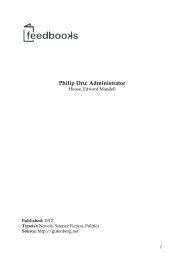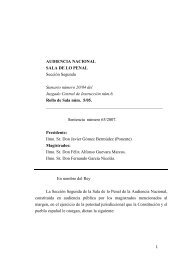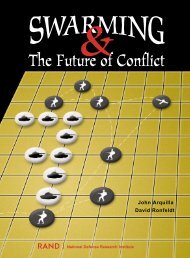Beyond START - Brookings Institution
Beyond START - Brookings Institution
Beyond START - Brookings Institution
You also want an ePaper? Increase the reach of your titles
YUMPU automatically turns print PDFs into web optimized ePapers that Google loves.
United States and Russia might be able to agree ona reduction to 1000 deployed strategic warheadson each side in the not-too-distant future, doing sowill not be possible this year. They should insteadnegotiate a treaty in 2009 that reduces each side’sforces to no more than 1500 deployed strategicnuclear warheads on 700 SNDVs.• Time: The negotiators have limited time, as <strong>START</strong>expires on December 5. In order to allow for Senateratification, the follow-on treaty likely must besigned by September. Washington and Moscowshould be prepared to consider some bridging arrangementshould they require additional time tofinalize and ratify the follow-on treaty.• Counting Rules: A priority task will be determiningthe counting rules for the new agreement. Indeveloping the follow-on treaty, the negotiatorsshould adopt <strong>START</strong>-type counting rules that attributea specific number of warheads to each typeof strategic ballistic missile and bomber. This willfacilitate counting and verification.• Downloading: For purposes of nuclear stability,neither side will want to concentrate its warheadson too few missile launchers or submarines.The follow-on treaty should include downloadingprovisions to allow the sides to remove warheadsfrom ballistic missiles, as <strong>START</strong> permitsto a limited extent, and also to allow removal ofsubmarine-launched ballistic missiles from missilecarryingsubmarines. Downloaded missiles wouldbe counted with fewer warheads and downloadedsubmarines with fewer missiles than they are otherwisecapable of carrying.• Conversion and Conventionally-Armed Systems: Thefollow-on treaty should contain provisions thatallow the sides to convert some strategic systemsto conventional-only roles and remove them frombeing accountable under the treaty. A potentiallydifficult issue will be conventional warheads ontreaty-accountable ballistic missiles.• Constraining Breakout Potential: The follow-ontreaty will need inspection measures and otherprocedures to prevent the rapid uploading ofdownloaded systems. This can be addressed byprovisions for inspections of downloaded systems,for preventing rapid uploading, and forverifiably eliminating excess ballistic missiles andwarheads.• Monitoring and Verification Measures: The sidesshould consider streamlining <strong>START</strong>’s verificationmeasures. However, the follow-on treatywill need sufficient monitoring measures to givethe sides confidence in their ability to verify theother’s compliance. In order to complete the treatyquickly, the sides should avoid new verificationprovisions where possible, though more intrusivemeasures will be needed in subsequent agreementsthat provide for deeper reductions.• Third-Country Strategic Forces: As U.S. and Russianstrategic force levels decrease, the strategic forcesof Britain, France, and China will assume greaterimportance. The United States and Russia shouldbe able to reduce their deployed strategic warheadsto 1500, or even 1000, without taking accountof third-country forces. However, at some pointthereafter those forces will have to be addressed,either through separate constraints or by multilateralizingthe U.S.-Russian strategic nuclear reductionsprocess.• Missile Defense: As U.S. and Russian strategic forcesare reduced, there will be greater pressure to addressmissile defense. This will have to be factoredin at some point, but the sides should be able tocut their forces to 1500, and perhaps 1000, deployedwarheads without limits on missile defensesystems. Bringing constraints on missile defenseinto the negotiation of the <strong>START</strong> follow-on treatywould likely make it impossible to have a treatyconcluded and ratified by December.• Tactical Nuclear Weapons: As U.S. and Russianstrategic nuclear forces are reduced, their tacticalnuclear weapons will assume greater importance.They can be left aside for the immediate negotiation,but will have to be addressed at some futurepoint as further strategic reductions are considered.2 B e y o n d <strong>START</strong>: Negotiating the Nex t Step in U.S. and Russian Strategic Nuclear Arms Reduc t i o n s



